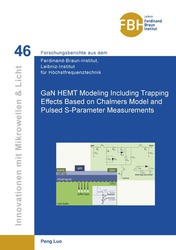| Departments | |
|---|---|
| Book Series (96) |
1378
|
| Nachhaltigkeit |
3
|
| Gesundheitswesen |
1
|
| Humanities |
2364
|
| Natural Sciences |
5406
|
| Engineering |
1793
|
| Engineering | 292 |
| Mechanical and process engineering | 862 |
| Electrical engineering | 686 |
| Mining and metallurgy | 30 |
| Architecture and civil engineering | 75 |
| Common |
98
|
|
Leitlinien Unfallchirurgie
5. Auflage bestellen |
|
Advanced Search
GaN HEMT Modeling Including Trapping Effects Based on Chalmers Model and Pulsed S-Parameter Measurements (Volume 46) (English shop)
Peng Luo (Author)Preview
Extract, PDF (610 KB)
Table of Contents, PDF (520 KB)
GaN HEMTs are regarded as one of the most promising RF power transistor technologies thanks to their high-voltage high-speed characteristics. However, they are still known to be prone to trapping effects, which hamper achievable output power and linearity. Hence, accurately and efficiently modeling the trapping effects is crucial in nonlinear large-signal modeling for GaN HEMTs.
This work proposes a trap model based on Chalmers model, an industry standard large-signal model. Instead of a complex nonlinear trap description, only four constant parameters of the proposed trap model need to be determined to accurately describe the significant impacts of the trapping effects, e.g., drain-source current slump, typical kink observed in pulsed I/V characteristics, and degradation of the output power. Moreover, the extraction procedure of the trap model parameters is based on pulsed S-parameter measurements, which allow to freeze traps and isolate the trapping effects from self-heating. The model validity is tested through small- and large-signal model verification procedures. Particularly, it is shown that the use of this trap model enables to dramatically improve the large-signal simulation results.
| ISBN-13 (Hard Copy) | 9783736999060 |
| ISBN-13 (eBook) | 9783736989061 |
| Final Book Format | A5 |
| Language | English |
| Page Number | 160 |
| Edition | 1. |
| Book Series | Innovationen mit Mikrowellen und Licht. Forschungsberichte aus dem Ferdinand-Braun-Institut, Leibniz-Institut für Höchstfrequenztechnik |
| Volume | 46 |
| Publication Place | Göttingen |
| Place of Dissertation | BTU Cottbus |
| Publication Date | 2019-01-09 |
| General Categorization | Dissertation |
| Departments |
Electrical engineering
|
| Keywords | Large-Signal Model Types,GaN Hemt,Outline of the Thesis,A1GAN/GaN,Ham,Extrinsic,Parameter,Extraction,Nonlinear,Circuit,Modeling,Capacitances,Large-signal,Physical,Mechanism,Trapping Effects,Gate-Lag,Drain-Lag,Published Models,Pulsed Measurements,Device,Self-Heating,Reduction,Traps Isolation,Intrinsic,Verification, Load Pull Performance,Model Limitations,Output,Conductance Match,Abbreviations, |








